A Scotland for the future: opportunities and challenges of Scotland's changing population
Scotland’s first national population strategy, framing the diverse and cross-cutting demographic challenges that Scotland faces at national and local level, and setting out a programme of work to address these challenges and harness new opportunities.
Scotland’s Population Story
Scotland's Population History
Centuries of demographic drivers – rates of fertility, mortality, and migration – have shaped Scotland's population story. Much of this story is told by numbers – the number of new-borns per year, the number of deaths, the numbers of those who leave Scotland to build a future elsewhere, and the numbers who arrive and settle here. But Scotland's story of demography is just as much about the events behind the numbers. Famines, industrialisation, the growth of cities, lowland and highland clearances, public health advances, bursts of emigration, wars, baby booms, freedom of movement – these are all key chapters that have formed our changing population.
In 1707, Scotland's population was thought to be around 1 million people. By 1855, official records show that Scotland's population stood at 2.98 million. Since then, Figure 3 demonstrates Scotland's steady population growth all the way to a record high of 5.46 million in 2019.
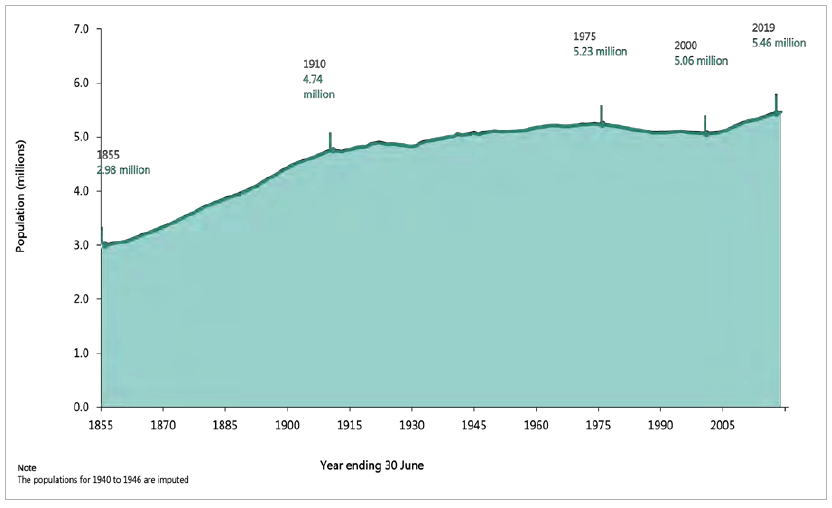
Over this history, there have been two drivers of Scotland's population change. During the 19th and first half of the 20th century, as Figure 4 shows, Scotland's population growth was largely driven by the number of births outweighing the number of deaths (otherwise known as 'natural change'). However, from 1975 to 2000, during a time where a falling birth rate coincided with sustained net outward migration (where more people were leaving Scotland to seek their futures elsewhere, than were arriving and settling), Scotland's population declined.
Since 2000, Scotland's population has grown again to a record high. But, as Figure 2 showed, this has not been the result of any 'natural change' through the number of births outstripping the number of deaths. Instead, population growth over the last two decades has been driven by a Scotland shifting from being a country of net-outward migration to one of sustained net inward migration.
Migration patterns fluctuate from year to year. However, as an overall trend, Figure 5 demonstrates how Scotland has shifted from a country of out-migration with more people leaving to both the rest of the UK and beyond to a country of in-migration.
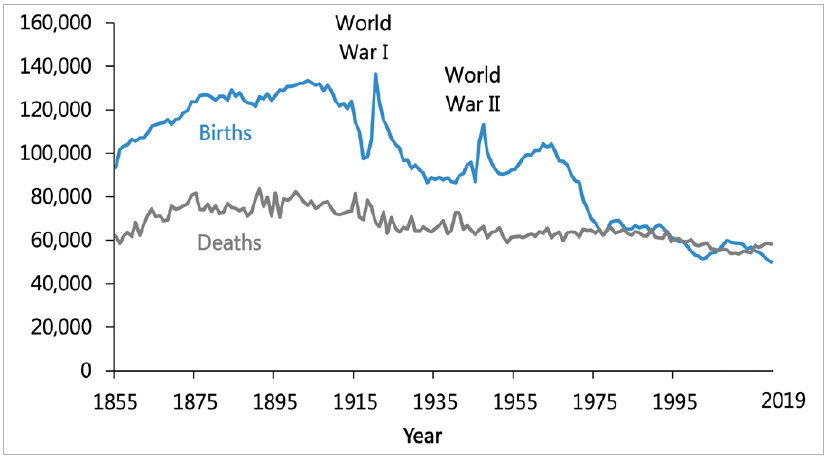
Along this timeline, Scotland's demographic journey has been unique. For example, compared with England and Wales, Scotland had slower population growth on average across every decade from 1851 to 2011. Throughout the 1950s and 1960s, where England and Wales saw strong in-migration, almost 6% of the population left Scotland in each decade. Scotland also experienced population decline throughout the 1970s, 1980s and 1990s whereas the UK as a whole saw almost constant growth in population over this period. Likewise, during this second half of the 20th century, population growth in Scotland was slower than in any other part of Western Europe.[11]
Yet, as a consequence of our unique demographic journey, one intertwined with emigration, Scotland's people and culture have long been spread across the world. Data from the 2009 US Census showed that more than 9 million Americans identified as having Scottish or Scottish-Irish ancestry while in the 2011 Canadian Census 4.7 million Canadians indicated Scottish ancestry.
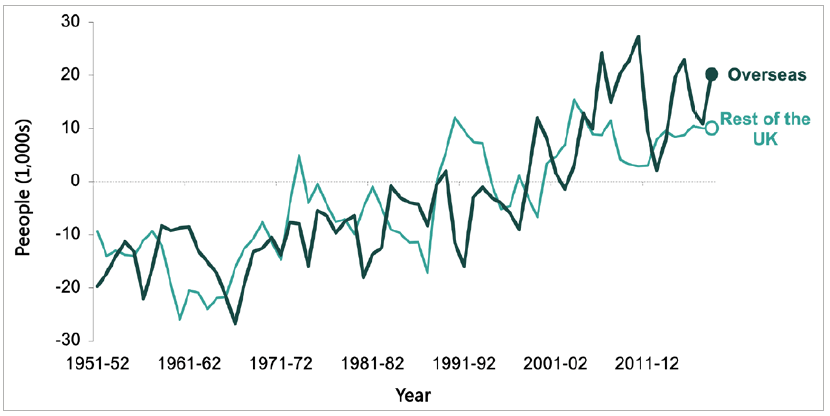
Together, these demographic indicators allow us to see how our population has changed through history. However, equally as important are the projections that forecast and frame our future population challenges.
Projections and challenges ahead
Population projections are often used to plan ahead. These projections highlight three significant population change challenges for a Scotland of the future:
- maintaining a sustainable total population size;
- maintaining sustainable age structures within our population;
- maintaining a sustainable spatial balance of our population across Scotland's urban, rural, and remote locations.
Our first projected challenge revolves around maintaining a sustainable overall population size. As Figure 6 shows, the National Records of Scotland (NRS) project that, with years of negative natural change (the number of deaths exceeding the number of births) ahead, all of our population growth over the next 20 years is projected to come from inward migration.
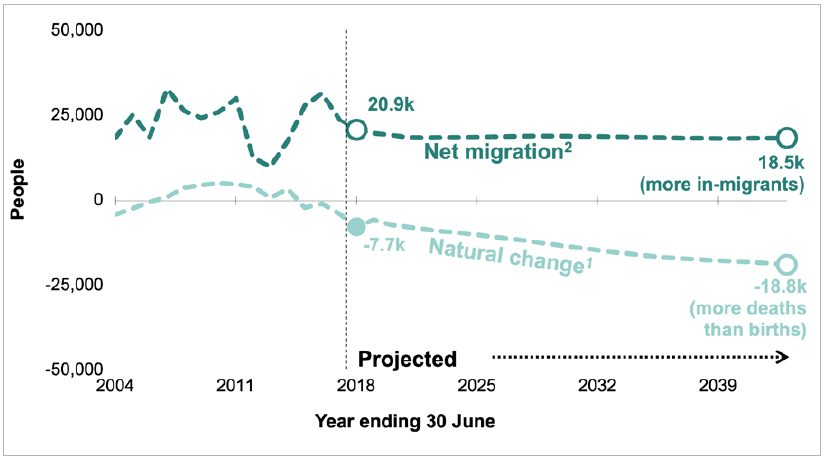
Given that these NRS projections do not take into account the ending of free movement between the UK and the European Single Market, it is possible that the challenge of Scotland maintaining a sustainable population size may be even more stark than projected.[13]
The Expert Advisory Group on Migration and Population has assessed the impact of the ending of freedom of movement and projected a reduction in annual overseas net migration to Scotland of between one third and one half after 2020 leading to a reduction in our working age population of between 3% and 5%.
The independent Expert Advisory Group on Migration and Population was established in October 2018. The Group's purpose is to provide independent expert analysis and advice to Scottish Government ministers on migration and population.
The group comprises of academics from five Scottish institutions:
- Professor Christina Boswell (chair) - University of Edinburgh
- Professor David Bell - University of Stirling
- Dr Andrew Copus – University of Eastern Finland and James Hutton Institute, Aberdeen
- Professor Rebecca Kay - University of Glasgow
- Professor Hill Kulu - University of St Andrews
The Group has produced five reports so far:
- UK immigration policy after leaving the EU: impacts on Scotland's economy, population and society
- Immigration policy and demographic change in Scotland: learning from Australia, Canada and continental Europe
- UK immigration policy after leaving the EU: impacts on Scotland's economy, population and society - July 2020 update
- Internal migration in Scotland and the UK: trends and policy lessons
- Designing a pilot remote and rural migration scheme: analysis and policy options
The second challenge focuses on not only maintaining a population size, but specially ensuring that the age structures of our population are sustainable. Like many Western countries, Scotland's population is ageing. Over decades, life expectancy has been increasing and the birth rate has been declining.[14] In 1980-1982, the life expectancy for a female in Scotland was 75.3 years and 69.1 years for a male. This jumped to 81.1 years for a female in 2017-2019 and 77.1 years for a male.
Though patterns of long life are marked by widespread inequality between our poorest and wealthiest communities,[15] long-term demographic trends of increased life expectancy and falling birth rates mean that the proportion of non-working age people is rising and is projected to rise dramatically over the coming decades. This is demonstrated through Figure 7.
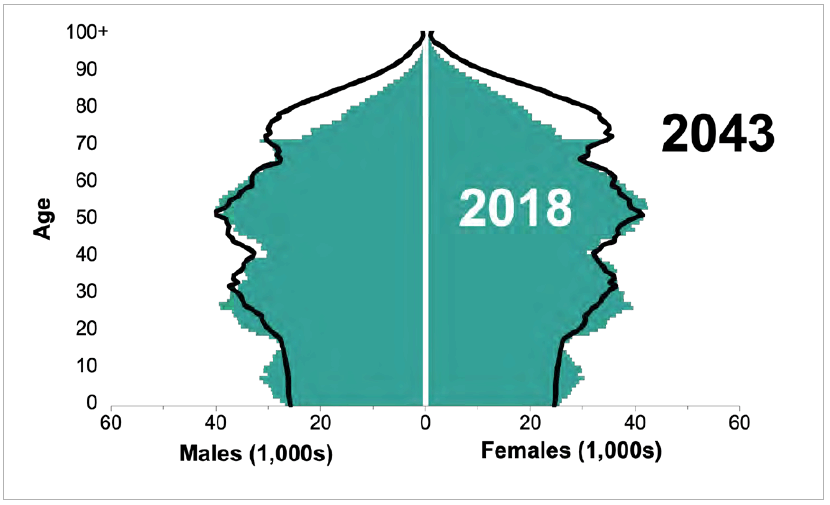
By mid-2043, it is projected that 22.9% of the population will be of pensionable age, compared to 19.0% in mid-2018. Scotland's age-structural shift is also projected to contain increasing numbers of people aged in the 'oldest old' age categories - the number of people aged 90 and over in Scotland is anticipated to double between 2019 and 2043 from 41,927 to 83,335.[16]
As the proportion of Scotland's pensionable age population grows, the proportions of both Scotland's working age and child population are projected to fall.[17,18] One implication of this projection is that a future Scotland may not have enough people of working age to replace those leaving the labour market as they grow older. Another implication is that without more working age people, pressures on fiscal sustainability, tax revenues, public services and welfare will increase.
We want a Scotland where everybody thrives. A Scotland where healthy life expectancy increases. A Scotland where people who enter retirement, having contributed so much during their working lives, are supported and have access to the services that they need. Many older people will continue to work to support their families and wider communities, which is welcome. We need to address the barriers that may constrain the ability of those people to contribute whilst also ensuring we have a skilled population to provide key public services and to generate the tax income to fund our public services and pensions.
The third challenge, in addition to maintaining a sustainable population size and age-balance in our population, is maintaining a sustainable balance of people across Scotland's urban, rural and remote areas.
Population change is important at a local as well as a national level, as each local authority in Scotland feels our demographic challenge differently. Some of our communities are facing significant population growth while many others, notably the west coast authorities and those in rural and remote areas, are facing depopulation as people move to larger towns and cities for employment and education opportunities.
Yet, whether a population is growing or declining, changing populations present numerous sustainability challenges to local areas. For those areas that are dealing with an increase in the population, this brings significant challenges in providing the infrastructure and services – housing, education, transport and health – to support this increased population. While, in contrast, areas dealing with decreasing (and often simultaneously ageing) populations face different challenges, including skill shortages and increased pressure on public services.
Figure 8 provides a snapshot (between mid-2018 and mid-2019) of the different demographic profiles of growth and decline by each local authority – each uniquely shaped by natural change and net-migration. In the latest year, the three local authorities experiencing the greatest population increase are all situated in the east (City of Edinburgh, East Lothian and Midlothian). While in contrast, 8 out of 32 council areas experienced depopulation – the greatest population declines were seen in Argyll and Bute, Inverclyde, and the Western Isles. It should be noted this still does not tell the whole story, as even within council areas, such as Highland, areas are experiencing severe depopulation as well as population growth.
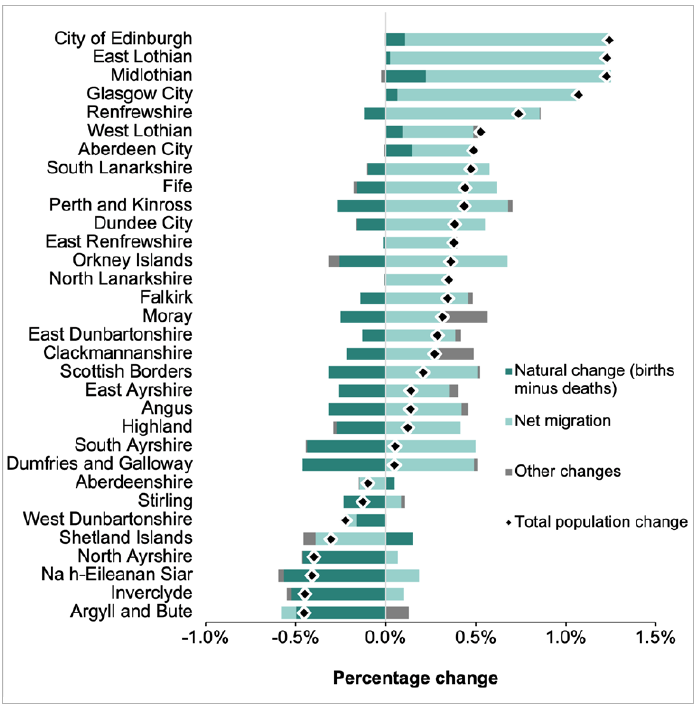
Figure 9 shows NRS projections of population growth and decline across local authority areas over the next decade. This highlights crucial patterns of deviation across the country, especially between eastern and western areas of Scotland.
Ultimately, Scotland's population story is multi-dimensional – bringing together a long history of growth and decline, migration, changing age-structural trends, and shifting local populations. Yet, as we set out this story and consider the sustainability challenges that lie ahead, we must remember that just as the actions of the past have shaped our current population, so too will the actions that we take now shape the future.
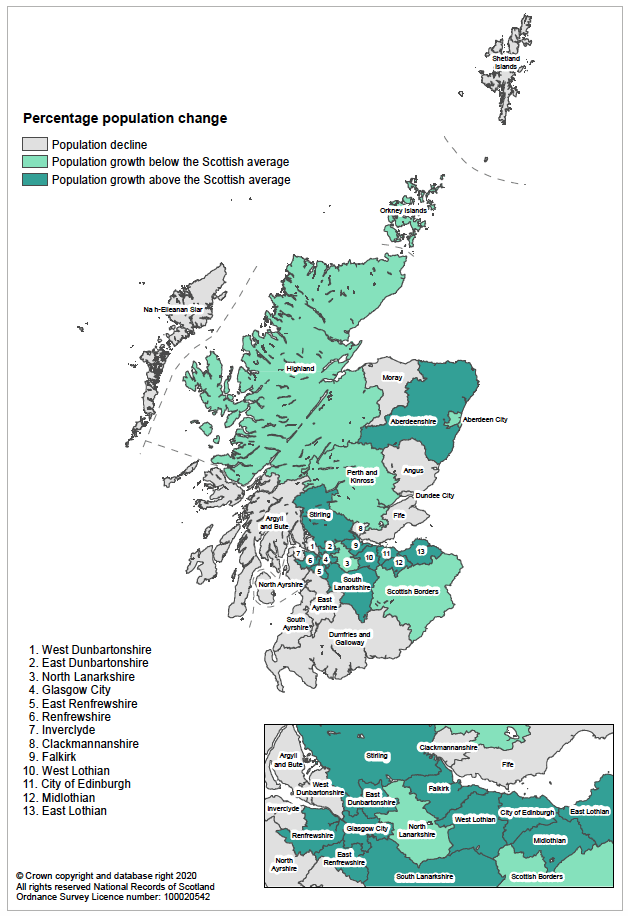
Contact
Email: population@gov.scot
There is a problem
Thanks for your feedback